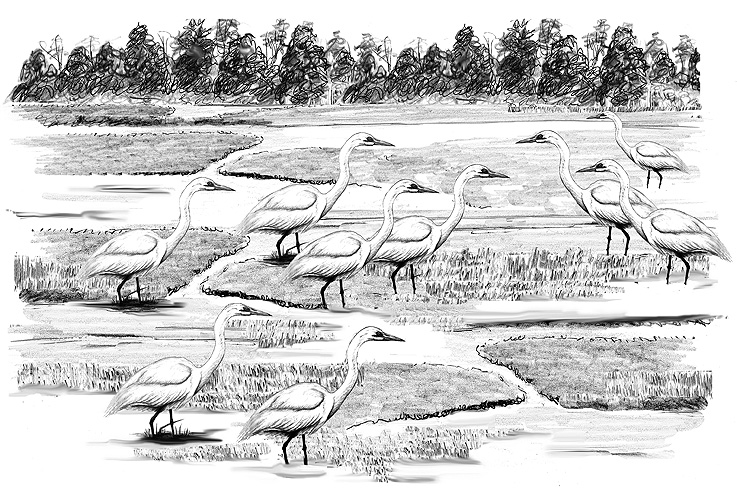
Dear Bird Folks,
Please find the attached photo of a big flock of tall white birds that were gathering in Rock Harbor Creek. Any explanation what is going on? Could it be an indication of a tough winter ahead or perhaps it’s a town meeting?
– Rick, Rock Harbor, MA
Take a deep breath, Rick,
I get excited when I see a lot of birds, too, but you were so wound up by your discovery that you sent me a note even before you finished writing it, and then had to send a second note just to complete your question. In addition, due to your excitement, you may have spelled your name wrong the second time, unless your name really is, “Ruck.” Now I’m not sure which is correct. While I don’t think those birds are getting ready for the coming winter, I like your idea of it being a possible town meeting. Remember in the pre-COVID days when town meetings were held at night, in dark, cramped auditoriums? Now we have them in the morning and in the fresh air. It makes for a pleasant natural experience, unless it’s raining, or hot or the kids want their soccer field back.
The birds in your photo are egrets. I count thirty of them, which makes for a pretty spectacular sighting. Lucky you. A few of the birds are Snowy Egrets, but most appear to be Great Egrets. Tall, thin and bright white, the Great Egret is one of the showiest birds we see in our area. Just about any salt marsh will produce one or two, or thirty. This species has made a dramatic recovery after being nearly wiped out by our old friends, the plume hunters. In the early part of the last century, people (mostly women and Yankee Doodle) thought it was somehow cool to walk around with feathers sticking out of their hats. The egret’s long, white breeding plumes, called “aigrettes,” were highly prized, and the birds paid the price. Not everyone liked the idea of killing birds in the name of fashion and eventually protective laws were passed. Once the killing stopped, the egret population began to recover. Funny how that works.
Historically, egrets are southern birds, but they have been slowly moving north. In 1954 the first Bay State pair of nesting Great Egrets was discovered in South Hanson. I didn’t even know there was a South Hanson, which makes me wonder how the birds found it, but they did. Today, Great Egrets are breeding in several locations in the state, including a few here on Cape Cod. Part of the reason for the egrets’ success is they’re not fussy. They will feed in ponds, tidal pools, drainage ditches, flooded fields and creeks, especially Rock Harbor Creek…or so I’ve been told. Even human disturbance doesn’t seem to faze them, as they readily adapt to our constant habitat changes. Their flexibility not only helps the birds survive in our area, but throughout much of the world as well. Great Egrets are also found in South America, Europe, Asia and Africa. They are indeed a successful species.
Before I continue, I just want to point out that in other parts of the world, in addition to Great Egrets, there’s also a smaller bird called the Little Egret. I’m okay with that, but there is an additional in-between species that goes by the name of “Intermediate Egret.” When I saw that I thought, really? Is that the best name they could come up with? Intermediate? How bland is that? What else do they have, the “Run-of-the-Mill Wren” and the “Slightly Above Average Swift”? Can’t bird people think of more imaginative names? I need to speak to someone about this.
When it comes to breeding, the eggs of most songbirds, waterfowl and game birds all basically hatch at the same time. Baby birds are vulnerable in the nest and the parents want their kids up and out as soon as possible, and all at the same time. This is not how egrets do it. One egg may hatch a day or two before the others, allowing the first chick to get head start on its nest mates. If there’s a food shortage, the late hatching birds often don’t make it. That sounds cruel, but that’s exactly how things were in my house. I’m pretty sure I once had a younger brother, but my sister, who was slightly above average, always managed to be at the dinner table first. Poor little Jimmy never had a chance.
Cape Cod is fortunate to be the home of several heron species, including the Great Egret’s bigger cousin, the Great Blue Heron. Most great blues are just returning to our area after spending the summer in off-Cape nesting colonies. Herons and egrets are rather similar, except the egret is far more sociable. Not to take anything away from your sighting, Ruck, but seeing a number of these tall white birds feeding or roosting together is fairly typical. Conversely, great blues can’t stand the sight of each other; a flock of one is all you are likely to see. In a saltwater pond near my house, the birds seem to spend more time chasing each other away and less time feeding. They remind me of Ruby-throated hummingbirds fighting over a feeder, only the herons are significantly larger, and I never hear them hum.
Thanks for sharing your photo, Rick. And once again, I like your idea of egrets being at the town meeting. I’d bet if we allowed birds to vote, we would have better conservation laws, including one law preventing feathers from being used in fashion. Sorry, Yankee Doodle, you’ll have to find something else to stick in your hat…perhaps actual macaroni.